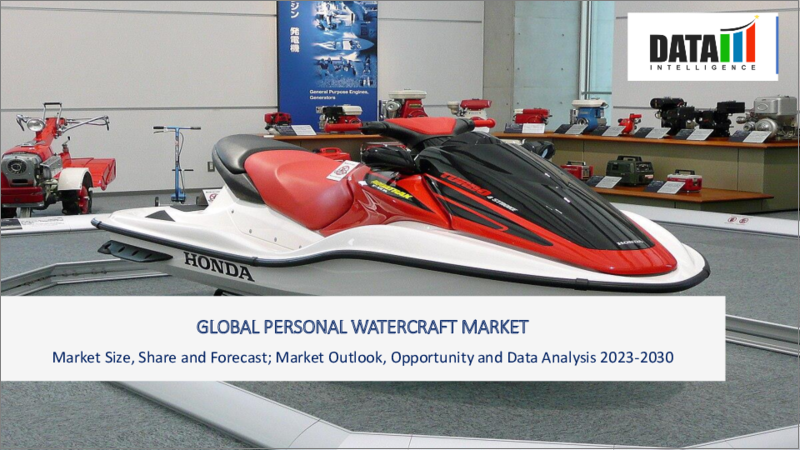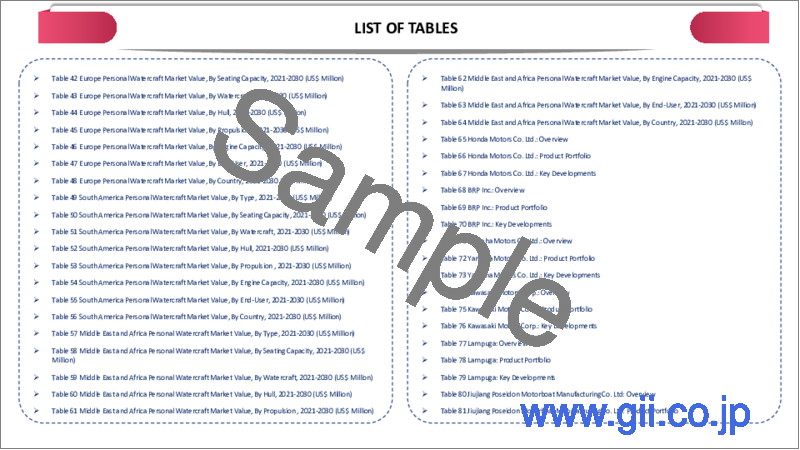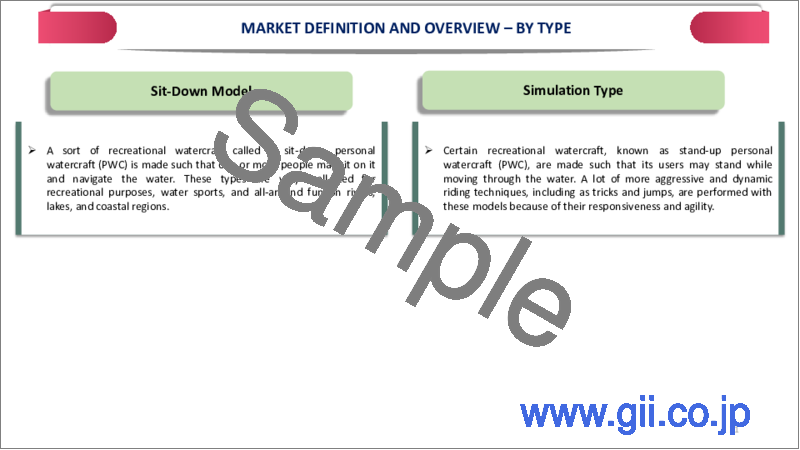|
|
市場調査レポート
商品コード
1336657
パーソナルウォータークラフトの世界市場-2023年~2030年Global Personal Watercraft Market - 2023-2030 |
||||||
カスタマイズ可能
適宜更新あり
|
|||||||
| パーソナルウォータークラフトの世界市場-2023年~2030年 |
|
出版日: 2023年08月22日
発行: DataM Intelligence
ページ情報: 英文 187 Pages
納期: 即日から翌営業日
|
- 全表示
- 概要
- 目次
市場概要
パーソナルウォータークラフトの世界市場は、2022年に16億米ドルに達し、2023~2030年の予測期間中にCAGR 4.7%で成長し、2030年には24億米ドルに達すると予測されています。
世界経済が成長を続ける中、可処分所得は増加傾向にあり、パーソナルウォータークラフトに乗るようなレクリエーション活動をする余裕がある人が増えています。さらに、より活動的で冒険的なライフスタイルの採用が動向となり、ウォータースポーツを含むアウトドア活動の探求を個人に促しています。さらに、世界の観光産業の隆盛は、パーソナルウォータークラフト市場の成長に大きく貢献しています。スリリングな体験や思い出に残る休暇を求める観光客が水上アクティビティを選ぶ傾向が強まっており、人気の旅行先でのパーソナルウォータークラフトのレンタルやツアーの需要を牽引しています。
レクリエーショナル・ウォータークラフトは、ウォータークラフトの中でも主要なカテゴリーとして急成長を遂げ、市場シェアの4分の1以上を占めています。このセグメントの著しい拡大は、レクリエーショナル・ウォータークラフトが水上でユニークで爽快な体験を提供することから、水上愛好家の間で人気が高まっていることに起因しています。同様に、パーソナルウォータークラフト・システム市場では、北米が圧倒的な地位を占め、4分の1を超える最大の市場シェアを占めています。同地域は、主に水上レクリエーション活動の人気上昇と消費者の可処分所得の伸びによって、この市場で大きな可能性を示しています。
市場力学
燃費効率に貢献する技術と設計の進歩
パーソナルウォータークラフト業界における技術の進歩は、市場の成長を促進する上で重要な役割を果たしています。メーカーは、パーソナルウォータークラフトの設計、性能、安全機能を向上させるため、研究開発に継続的に投資しています。インテリジェントブレーキ&リバース(iBR)システム、可変トリムシステム(VTS)、電子制御モジュール(ECM)などの高度な機能は、パーソナルウォータークラフトの全体的な乗り心地と安全性を向上させています。こうした技術革新は、経験豊富なライダーと初心者ライダーの両方の関心を集め、市場の成長を促進しています。
近年、環境意識と持続可能性は、パーソナルウォータークラフト市場を含むあらゆる産業において、消費者にとって重要な関心事となっています。メーカー各社は、環境に優しく燃費の良いパーソナルウォータークラフト・モデルの開発にますます力を入れるようになっています。世界各国の政府によって設定された環境規制と排出基準は、メーカーがより環境に優しい慣行を採用し、より環境に優しいウォータークラフトを生産するよう影響を与えています。その結果、同市場には、燃費が良く環境に優しい選択肢を求める環境意識の高い消費者が流入しています。
流通網の拡大とマーケティングの努力
世界のパーソナルウォータークラフト(PWC)市場は、近年大幅な成長を遂げています。市場を牽引しているのは、消費者の需要の増加と市場の拡大をもたらしたさまざまな要因です。流通網の拡大とマーケティング努力は、市場を押し上げた主な要因です。それぞれの市場促進要因が整ったことで、市場は当分の間、継続的な拡大と繁栄を目の当たりにすることになると思われます。
パーソナルウォータークラフト市場の成長は、流通網の拡大と効果的なマーケティング戦略によって支えられてきました。メーカーは販売店や小売店と提携し、潜在顧客へのリーチを広げています。さらに、デジタルプラットフォーム、ソーシャルメディア、イベントを通じた積極的なマーケティング努力は、ターゲット層のパーソナルウォータークラフトに対する認知度を高め、興味を喚起するのに役立っています。このような流通とマーケティング努力は、知名度の向上と売上の押し上げにつながり、市場の拡大に寄与しています。
安全性への懸念と事故、高い維持費、市場の季節性
パーソナルウォータークラフト市場では、安全性が依然として大きな懸念事項となっています。最新のPWCモデルには安全機能が装備され、安全運転のためのガイドラインが定められていますが、事故や衝突は後を絶たず、負傷者や死亡者が出ています。米国の国家運輸安全委員会(NTSB)などの政府機関は、パーソナルウォータークラフトの事故を定期的に報告しています。こうした事故を受けて、規制当局はより厳格な安全規制を導入し、パーソナルウォータークラフトの操縦者に免許や訓練の要件を課しています。
さらに、パーソナルウォータークラフトの整備・修理費用は比較的高額になります。特殊な技術や部品を使用しているため、安全で効率的な運航を確保するためには、定期的なメンテナンスや整備が必要となります。消費者にとっては、整備費用が高いことが、パーソナルウォータークラフトの購入や所有を躊躇させることになります。さらに、パーソナルウォータークラフト市場は季節要因の影響を強く受けます。人々が水上レクリエーション活動を行う温暖な時期に需要がピークを迎えます。
COVID-19の影響分析
COVID-19パンデミックは、主に旅行の制限、経済の不確実性、消費者行動の変化、可処分所得の減少により、世界のパーソナルウォータークラフト市場にかつてない課題をもたらしました。パンデミックによる経済不況は、個人と企業を問わず、広範な雇用喪失と経済的不安をもたらしました。人々が経済的不安に直面したことで、パーソナルウォータークラフトのようなレジャー活動を含め、不要不急の支出は後回しにされました。
多くの国々で、パーソナルウォータークラフトの販売・レンタル収益が低下しました。例えば、パーソナルウォータークラフトの最大市場の1つである米国では、経済分析局(BEA)のデータによると、2020年のレクリエーション用品・車両に対する個人消費支出は2019年と比較して3.1%減少しました。
しかし、規制が徐々に緩和され、予防接種キャンペーンが展開されていることから、パーソナルウォータークラフト市場には回復の兆しが見られます。景気が回復し、旅行が再開するにつれて、パーソナルウォータークラフトの需要は増加すると予想されます。各国政府の支援策とレクリエーション産業への投資は、今後数年間の市場成長の可能性をさらに高めます。完全回復への道のりは緩やかかもしれませんが、世界が新しい日常に適応していく中で、パーソナルウォータークラフト市場は有望な展望を秘めています。
目次
第1章 調査手法と調査範囲
第2章 定義と概要
第3章 エグゼクティブサマリー
第4章 市場力学
- 影響要因
- 促進要因
- 水上インフラ、観光、水上アドベンチャーの拡大
- 可処分所得とレジャー支出の増加、水上スポーツとレクリエーション活動の人気の高まり
- 燃費効率に貢献する技術と設計の進歩
- 流通網とマーケティング活動の拡大
- 抑制要因
- 騒音公害への懸念と厳しい環境規制
- 安全性への懸念と事故、高い整備費用、市場の季節性
- 機会
- 影響分析
- 促進要因
第5章 産業分析
- ポーターのファイブフォース分析
- サプライチェーン分析
- 価格分析
- 規制分析
第6章 COVID-19分析
第7章 座席数別
- スタンディング
- 1人乗り
- 2人乗り
- 3人乗り
第8章 ウォータークラフトのタイプ別
- レクリエーショナル・ウォータークラフト
- マッスル・ウォータークラフト
- 高級ウォータークラフト
- パフォーマンス・ウォータークラフト
- スポーツ・ウォータークラフト
第9章 船体別
- プラスチック
- 複合材料
第10章 地域別
- 北米
- 米国
- カナダ
- メキシコ
- 欧州
- ドイツ
- 英国
- フランス
- イタリア
- ロシア
- その他欧州
- 南米
- ブラジル
- アルゼンチン
- その他南米
- アジア太平洋
- 中国
- インド
- 日本
- オーストラリア
- その他アジア太平洋
- 中東・アフリカ
第11章 競合情勢
- 競合シナリオ
- 市況/シェア分析
- M&A分析
第12章 企業プロファイル
- Honda Motors Co. Ltd.
- 会社概要
- 製品ポートフォリオと説明
- 財務概要
- 主な動向
- BRP Inc.
- Yamaha Motors Co. Ltd.
- Kawasaki Motors Corp.
- Lampuga
- Jiujiang Poseidon Motorboat Manufacturing Co. Ltd.
- BRO Inc
- Arctic cat Inc
- Polaris Industries
- SLVH s.r.o.
第13章 付録
Market Overview
Global personal watercraft market reached US$ 1.6 billion in 2022 and is expected to reach US$ 2.4 billion by 2030, growing with a CAGR of 4.7% during the forecast period 2023-2030.
As the global economy continues to grow, disposable incomes have been on the rise, enabling more people to afford recreational activities like personal watercraft riding. Additionally, the adoption of a more active and adventurous lifestyle has become a trend, encouraging individuals to explore outdoor activities, including water sports. Moreover, the flourishing global tourism industry has significantly contributed to the growth of the personal watercraft market. Tourists seeking thrilling experiences and memorable vacations are increasingly opting for water-based activities, driving the demand for personal watercraft rentals and tours in popular travel destinations.
The recreational watercraft segment has emerged as the leading category within the watercraft type segment, experiencing rapid growth and capturing more than a quarter of the market share. The remarkable expansion of this segment can be attributed to the increasing popularity of recreational watercraft among water enthusiasts, as it offers a unique and exhilarating experience on the water. Similarly, in the personal watercraft system market, North America holds the dominant position, commanding the largest market share of over a quarter. The region showcases significant potential in this market, primarily driven by the rising popularity of water-based recreational activities and the growth of disposable incomes among consumers.
Market Dynamics
Advancements in Technology and Design Contributing to Fuel Efficiency
The technological advancements in the personal watercraft industry have played a crucial role in driving market growth. Manufacturers have been continuously investing in research and development to improve the design, performance, and safety features of personal watercraft. Advanced features such as Intelligent Brake & Reverse (iBR) systems, Variable Trim Systems (VTS), and Electronic Control Modules (ECM) have enhanced the overall riding experience and safety of personal watercraft. Such technological innovations have garnered the interest of both experienced and novice riders, driving market growth.
In recent years, environmental awareness and sustainability have become critical considerations for consumers across industries, including the personal watercraft market. Manufacturers are increasingly focusing on developing eco-friendly and fuel-efficient personal watercraft models. Environmental regulations and emission standards set by governments globally are influencing manufacturers to adopt greener practices and produce more environmentally-friendly watercraft. Consequently, the market is witnessing an influx of eco-conscious consumers seeking fuel-efficient and environmentally-friendly options.
Expanding Distribution Networks and Marketing Efforts
The global personal watercraft (PWC) market has been experiencing substantial growth in recent years. The market is driven by various factors that have led to an increase in consumer demand and market expansion. Expanding distribution networks and marketing efforts is a major factor that have boosted the market. With the respective market driver in place, the market is poised to witness continued expansion and prosperity in the foreseeable future.
The personal watercraft market growth has been supported by expanding distribution networks and effective marketing strategies. Manufacturers are partnering with dealerships and retailers to increase their reach to potential customers. Moreover, aggressive marketing efforts through digital platforms, social media, and events have helped raise awareness and generate interest in personal watercraft among the target audience. These distribution and marketing efforts have led to increased visibility and boosted sales, contributing to market expansion.
Safety Concerns and Accidents, High Maintenance Costs and Seasonal Nature of the Market
Safety remains a significant concern in the personal watercraft market. While modern PWC models are equipped with safety features and guidelines for safe operation, accidents and collisions continue to occur, leading to injuries and fatalities. Government agencies, such as the National Transportation Safety Board (NTSB) in U.S., regularly report accidents involving personal watercraft. Such incidents prompt regulators to introduce stricter safety regulations and impose licensing and training requirements for personal watercraft operators.
Moreover, the maintenance and repair costs of personal watercraft can be relatively high. The specialized technology and components require regular maintenance and servicing to ensure safe and efficient operation. For consumers, high maintenance costs can deter them from purchasing or owning personal watercraft. Additionally, the personal watercraft market is highly influenced by seasonal factors. It experiences peak demand during the warm months when people engage in water-based recreational activities.
COVID-19 Impact Analysis
The COVID-19 pandemic brought unprecedented challenges to the global personal watercraft market, primarily due to travel restrictions, economic uncertainty, changes in consumer behavior, and reduced disposable income. The pandemic-induced economic recession resulted in widespread job losses and financial insecurity for individuals and businesses alike. With people facing financial uncertainty, non-essential spending, including leisure activities like personal watercraft, took a backseat.
Various countries have experienced declines in personal watercraft rental and sales revenue.For instance, U.S., one of the largest markets for personal watercraft, data from the Bureau of Economic Analysis (BEA) shows that personal consumption expenditures on recreational goods and vehicles decreased by 3.1% in 2020 compared to 2019.
However, with the gradual easing of restrictions and the rollout of vaccination campaigns, there are signs of recovery in the personal watercraft market. As economies rebound and travel resumes, the demand for personal watercraft is expected to increase. Governments' support measures and investments in recreational industries further contribute to the market's potential for growth in the coming years. While the road to full recovery may be gradual, the personal watercraft market holds promising prospects as the world adapts to the new normal.
Segment Analysis
The global personal watercraft market is segmented based on seating capacity, watercraft type, hull and region.
Ability of Recreational Watercrafts to offer Unique and Exhilarating Experience for Water Enthusiasts
Personal watercraft, also known as jet skis, are versatile and thrilling watercraft that offers a unique and exhilarating experience for water enthusiasts. As more people seek leisure activities and outdoor adventures, the recreational watercraft segment has emerged as a dominant force within the global market. Moreover, tourists seeking unique experiences are opting for jet ski rentals and tours, boosting the demand in popular tourist destinations. Governments around the world have recognized the potential economic impact of the personal watercraft market.
As a result, many countries have implemented policies and regulations to support water sports and recreational activities. Such policies create opportunities for businesses to expand their operations, driving the growth of the recreational watercraft segment. For instance, in Australia, the Australian Bureau of Statistics reported an increase in the number of personal watercraft registrations. In 2015, there were 43,349 registered personal watercraft, and by 2020, this number had grown to 54,927, representing a significant uptick in demand for recreational watercraft.
Similalry, the European market has also witnessed substantial growth in the recreational watercraft segment. Data from the European Boating Industry indicates that personal watercraft accounted for approximately 18% of the total boat registrations in Europe in 2015. By 2020, this share had increased to around 20%, underscoring the segment's expansion in the region.
Geographical Analysis
Presence of Vast Coastline, Numerous Lakes and Water-Friendly Culture in North America
U.S. dominates the personal watercraft market in North America. With its vast coastline, numerous lakes, and water-friendly culture, the U.S. has emerged as a significant player in the global personal watercraft industry. Similalry, Canada's expansive water bodies and scenic locations have also contributed to the growth of the personal watercraft market. The country's strong tourism industry and water sports culture have driven demand for these watercraft.
The outbreak of the COVID-19 pandemic in 2020 had a mixed impact on the personal watercraft market in North America. While the initial months saw a decline in sales due to lockdowns and restrictions on recreational activities, the market experienced a surge in demand later in the year. As people sought safe and socially distant outdoor activities, water sports gained popularity, leading to increased sales of personal watercraft. With the continued focus on sustainability and emerging markets, the personal watercraft industry is poised for further growth in North America.
Competitive Landscape
Honda Motors Co. Ltd., BRP Inc., Yamaha Motors Co. Ltd., Kawasaki Motors Corp., Lampuga, Jiujiang Poseidon Motorboat Manufacturing Co. Ltd., BRO Inc, Arctic cat Inc, Polaris Industries and SLVH s.r.o.
Why Purchase the Report?
- To visualize the global personal watercraft market segmentation based on seating capacity, watercraft type, hull and region, as well as understand key commercial assets and players.
- Identify commercial opportunities by analyzing trends and co-development.
- Excel data sheet with numerous data points of personal watercraft market-level with all segments.
- PDF report consists of a comprehensive analysis after exhaustive qualitative interviews and an in-depth study.
- Product mapping available as excel consisting of key products of all the major players.
The global personal watercraft market report would provide approximately 61 tables, 59 figures and 187 Pages.
Target Audience 2023
- Manufacturers/ Buyers
- Industry Investors/Investment Bankers
- Research Professionals
- Emerging Companies
Table of Contents
1. Methodology and Scope
- 1.1. Research Methodology
- 1.2. Research Objective and Scope of the Report
2. Definition and Overview
3. Executive Summary
- 3.1. Snippet by Seating Capacity
- 3.2. Snippet by Watercraft Type
- 3.3. Snippet by Hull
- 3.4. Snippet by Region
4. Dynamics
- 4.1. Impacting Factors
- 4.1.1. Drivers
- 4.1.1.1. Expanding Water-based Infrastructure, Tourism and Water-based Adventure
- 4.1.1.2. Rising Disposable Income and Leisure Spending Combined with Growing Popularity of Water Sports and Recreational Activities
- 4.1.1.3. Advancements in Technology and Design Contributing to Fuel Efficiency
- 4.1.1.4. Expanding Distribution Networks and Marketing Efforts
- 4.1.2. Restraints
- 4.1.2.1. Noise Pollution Concerns and Stringent Environmental Regulations
- 4.1.2.2. Safety Concerns and Accidents, High Maintenance Costs and Seasonal Nature of the Market
- 4.1.3. Opportunity
- 4.1.4. Impact Analysis
- 4.1.1. Drivers
5. Industry Analysis
- 5.1. Porter's Five Force Analysis
- 5.2. Supply Chain Analysis
- 5.3. Pricing Analysis
- 5.4. Regulatory Analysis
6. COVID-19 Analysis
- 6.1. Analysis of COVID-19
- 6.1.1. Scenario Before COVID
- 6.1.2. Scenario During COVID
- 6.1.3. Scenario Post COVID
- 6.2. Pricing Dynamics Amid COVID-19
- 6.3. Demand-Supply Spectrum
- 6.4. Government Initiatives Related to the Market During Pandemic
- 6.5. Manufacturers Strategic Initiatives
- 6.6. Conclusion
7. By Seating Capacity
- 7.1. Introduction
- 7.1.1. Market Size Analysis and Y-o-Y Growth Analysis (%), By Seating Capacity
- 7.1.2. Market Attractiveness Index, By Seating Capacity
- 7.2. Standing*
- 7.2.1. Introduction
- 7.2.2. Market Size Analysis and Y-o-Y Growth Analysis (%)
- 7.3. One Seat Capacity
- 7.4. Two Seat Capacity
- 7.5. Three Seat Capacity
8. By Watercraft Type
- 8.1. Introduction
- 8.1.1. Market Size Analysis and Y-o-Y Growth Analysis (%), By Watercraft Type
- 8.1.2. Market Attractiveness Index, By Watercraft Type
- 8.2. Recreational Watercraft*
- 8.2.1. Introduction
- 8.2.2. Market Size Analysis and Y-o-Y Growth Analysis (%)
- 8.3. Muscle Watercraft
- 8.4. Luxury Watercraft
- 8.5. Performance Watercraft
- 8.6. Sports Watercraft
9. By Hull
- 9.1. Introduction
- 9.1.1. Market Size Analysis and Y-o-Y Growth Analysis (%), By Hull
- 9.1.2. Market Attractiveness Index, By Hull
- 9.2. Plastics*
- 9.2.1. Introduction
- 9.2.2. Market Size Analysis and Y-o-Y Growth Analysis (%)
- 9.3. Composites
10. By Region
- 10.1. Introduction
- 10.1.1. Market Size Analysis and Y-o-Y Growth Analysis (%), By Region
- 10.1.2. Market Attractiveness Index, By Region
- 10.2. North America
- 10.2.1. Introduction
- 10.2.2. Key Region-Specific Dynamics
- 10.2.3. Market Size Analysis and Y-o-Y Growth Analysis (%), By Seating Capacity
- 10.2.4. Market Size Analysis and Y-o-Y Growth Analysis (%), By Watercraft Type
- 10.2.5. Market Size Analysis and Y-o-Y Growth Analysis (%), By Hull
- 10.2.6. Market Size Analysis and Y-o-Y Growth Analysis (%), By Country
- 10.2.6.1. U.S.
- 10.2.6.2. Canada
- 10.2.6.3. Mexico
- 10.3. Europe
- 10.3.1. Introduction
- 10.3.2. Key Region-Specific Dynamics
- 10.3.3. Market Size Analysis and Y-o-Y Growth Analysis (%), By Seating Capacity
- 10.3.4. Market Size Analysis and Y-o-Y Growth Analysis (%), By Watercraft Type
- 10.3.5. Market Size Analysis and Y-o-Y Growth Analysis (%), By Hull
- 10.3.6. Market Size Analysis and Y-o-Y Growth Analysis (%), By Country
- 10.3.6.1. Germany
- 10.3.6.2. UK
- 10.3.6.3. France
- 10.3.6.4. Italy
- 10.3.6.5. Russia
- 10.3.6.6. Rest of Europe
- 10.4. South America
- 10.4.1. Introduction
- 10.4.2. Key Region-Specific Dynamics
- 10.4.3. Market Size Analysis and Y-o-Y Growth Analysis (%), By Seating Capacity
- 10.4.4. Market Size Analysis and Y-o-Y Growth Analysis (%), By Watercraft Type
- 10.4.5. Market Size Analysis and Y-o-Y Growth Analysis (%), By Hull
- 10.4.6. Market Size Analysis and Y-o-Y Growth Analysis (%), By Country
- 10.4.6.1. Brazil
- 10.4.6.2. Argentina
- 10.4.6.3. Rest of South America
- 10.5. Asia-Pacific
- 10.5.1. Introduction
- 10.5.2. Key Region-Specific Dynamics
- 10.5.3. Market Size Analysis and Y-o-Y Growth Analysis (%), By Seating Capacity
- 10.5.4. Market Size Analysis and Y-o-Y Growth Analysis (%), By Watercraft Type
- 10.5.5. Market Size Analysis and Y-o-Y Growth Analysis (%), By Hull
- 10.5.6. Market Size Analysis and Y-o-Y Growth Analysis (%), By Country
- 10.5.6.1. China
- 10.5.6.2. India
- 10.5.6.3. Japan
- 10.5.6.4. Australia
- 10.5.6.5. Rest of Asia-Pacific
- 10.6. Middle East and Africa
- 10.6.1. Introduction
- 10.6.2. Key Region-Specific Dynamics
- 10.6.3. Market Size Analysis and Y-o-Y Growth Analysis (%), By Seating Capacity
- 10.6.4. Market Size Analysis and Y-o-Y Growth Analysis (%), By Watercraft Type
- 10.6.5. Market Size Analysis and Y-o-Y Growth Analysis (%), By Hull
11. Competitive Landscape
- 11.1. Competitive Scenario
- 11.2. Market Positioning/Share Analysis
- 11.3. Mergers and Acquisitions Analysis
12. Company Profiles
- 12.1. Honda Motors Co. Ltd.*
- 12.1.1. Company Overview
- 12.1.2. Product Portfolio and Description
- 12.1.3. Financial Overview
- 12.1.4. Key Developments
- 12.2. BRP Inc.
- 12.3. Yamaha Motors Co. Ltd.
- 12.4. Kawasaki Motors Corp.
- 12.5. Lampuga
- 12.6. Jiujiang Poseidon Motorboat Manufacturing Co. Ltd.
- 12.7. BRO Inc
- 12.8. Arctic cat Inc
- 12.9. Polaris Industries
- 12.10. SLVH s.r.o.
LIST NOT EXHAUSTIVE
13. Appendix
- 13.1. About Us and Services
- 13.2. Contact Us






